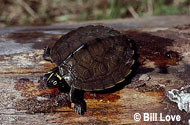Description:
False map turtles are generally docile and do not bite. They are creatures of flowing water and will require large aquatic environments with adequate filtration. The females get relatively large, and thus pose a challenge in an indoor setting. The water can be deep as map turtles are adept swimmers, however log snags should provide structure as these turtles will often choose to rest while submerged underwater. A basking site is a requirement and the turtles must be able to dry both their carapace and plastron completely on occasion. Otherwise, shell problems, such as fungus and rot may develop. Map turtles, in general, seem more sensitive to these issues than other species, such as painted turtles and sliders. A basking light that provides warmth, of at least 80 degrees Fahrenheit as well as multi-spectrum lighting, is also important. False map turtles are generally carnivorous, although some plant material may occasionally be eaten. Freshwater mussels and snails are favorite foods. Introduced Asiatic clams are also eaten. Aquatic insects such as caddis flies and stoneflies may be gleaned from sunken logs and submerged rocks. In captivity, false map turtles will eat turtle pellets, but their diet should also be supplemented with a commercial feed containing crustaceans.
Habitat:
The false map turtle occurs in large rivers and their tributaries. Occasionally they are found in floodplain ponds, oxbows, and backwaters, but usually in association with the river and moving water. They are fond of basking and often choose log snags on which they may climb several feet above the water surface.
Range:
The false map turtles is found in large river systems of the Missouri, upper Mississippi, and Ohio drainages. Therefore, its range includes the states of Indiana, Kentucky, Illinois, Minnesota, Missouri, and then northwestward into Nebraska and the Dakotas.
Scientific Name: Graptemys pseudogeographica
Species Group: turtle
Family: Emydidae
Size: Females are generally larger (up to 10½ inches) while males are only approximately 6 inches.
Level: intermediate
Weight: N/A
Dangerous: No


